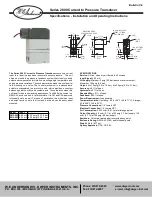
14
MDS 4710/9710 Technical Manual
MDS 05-3305A01, Rev. E
If all parameters are correctly set, start radio operation by following
these steps:
1. Apply DC power to the transceiver.
2. Observe the LED status panel for the proper indications (
Table 7
).
3. If not done earlier, refine the antenna heading of the station to maxi-
mize the received signal strength (RSSI) from the master station.
Use the
RSSI
command from an HHT connected to the radio’s
DIAG
connector. See
Section 4.0, TRANSCEIVER PROGRAMMING
on
Page 15
. This can also be done with a DC voltmeter as described in
Section 3.2, RSSI Measurement
(
Page 14
).
3.1 LED Indicators
Table 7
describes the function of each status LED.
3.2 RSSI Measurement
As an alternative to using an HHT, the radio’s received signal strength
(RSSI) can be read with a DC voltmeter connected to Pin 21 of the
DATA
INTERFACE
connector.
Figure 8
shows the relationship between
received signal level and the DC voltage on Pin 21 of the
DATA INTER-
FACE
connector. (Note: Readings are not accurate for incoming signal
strengths above –50 dBm.)
PWR
DCD
TXD
RXD
Table 7. LED Status Indicators
LED Name
Description
PWR
• Continuous—Power is applied to the radio, no problems detected.
• Rapid flash (five times-per-second)—Fault indication.
• Flashing once every 5 seconds—Radio is in Sleep mode.
DCD
• Flashing—Indicates the radio is receiving intermittent data frames.
• Continuous—Radio is receiving a data signal from a continuously
keyed radio.
TXD
An EIA-232 mark signal is being received at the DATA INTERFACE
connector.
RXD
An EIA-232 mark signal is being sent out from the DATA INTERFACE
connector.
















































